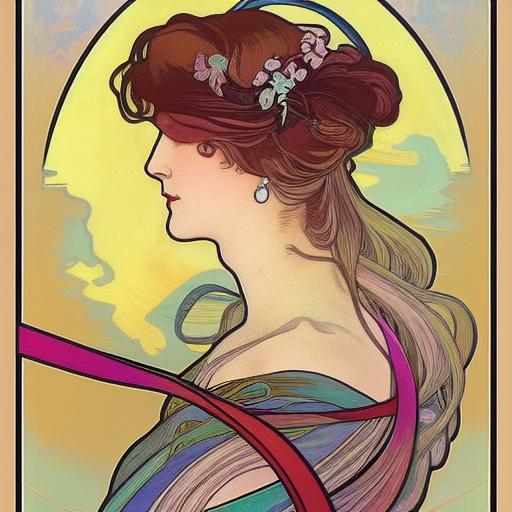How the prompt affect AI Image Generation
Let’s take a look at the Prompt of the image. When we consider the prompt “a painting of a woman with a ribbon in her hair, poster art inspired by Alphonse Mucha, art nouveau, in the style of Alphonse Mucha, Alsphonse Mucha, Alphons Mucha,” we delve into the world of art nouveau and the distinct influence of Alphonse Mucha on poster art.
The mention of a woman with a ribbon in her hair sets the visual focus of the painting, creating an elegant and charming subject. The prompt specifically directs the AI image generator to produce a poster-style artwork, taking inspiration from the iconic style of Alphonse Mucha, a celebrated artist of the art nouveau movement.
The art nouveau aesthetic is characterized by its intricate and ornamental designs, flowing lines, and harmonious compositions. By incorporating elements from the style of Alphonse Mucha, such as his use of vibrant colors, organic forms, and decorative patterns, the AI image generator can emulate the essence of Mucha’s iconic poster art.
Through the collaboration between the prompt and the AI image generator, such as Stable Diffusion and DALL-E , a visually captivating artwork emerges, showcasing the beauty and allure of art nouveau poster art, reminiscent of the style of Alphonse Mucha. The AI’s ability to interpret and translate textual prompts into visually stunning compositions allows for the creation of unique and captivating artworks that pay homage to the art nouveau movement and its prominent figures.
Ribbons in Art Nouveau
Ribbons are a common element found in Art Nouveau artwork. They are often used as decorative motifs, adding a sense of elegance, fluidity, and movement to the composition. Ribbons in Art Nouveau are characterized by their sinuous, curvilinear forms, which echo the overall organic and flowing aesthetic of the style.
The use of ribbons in Art Nouveau serves multiple purposes. Firstly, they can be employed as framing devices, gracefully enveloping and enclosing the central subject or design elements. This creates a sense of harmony and balance within the composition while also drawing attention to the focal point. Ribbons may also serve as connectors or links between different elements in the artwork, visually tying them together and enhancing the overall cohesion of the design.
In addition to their decorative function, ribbons in Art Nouveau often convey symbolic meanings. They can symbolize unity, connection, or the intertwining of different ideas or elements. The flowing and undulating nature of ribbons reflects the emphasis on natural forms and the celebration of organic beauty in Art Nouveau. Furthermore, ribbons may evoke a sense of movement or dynamic energy, enhancing the overall visual impact of the artwork.
The use of ribbons in Art Nouveau is closely related to the broader theme of ornamentation and the emphasis on intricate and elaborate details. Ribbons, along with other decorative elements like floral patterns and swirling lines, contribute to the overall richness and intricacy of Art Nouveau artworks. They add depth and visual interest, making the compositions more visually captivating and engaging.
Simple Background in Art Nouveau
While Art Nouveau artworks are often characterized by their intricate and elaborate backgrounds, there are indeed instances where simplicity is employed. While the elaborate and highly detailed backgrounds are a signature feature of the style, some artists chose to simplify the background to create a different effect or to draw attention to the central subject of the artwork.
In some Art Nouveau works, a simple background is intentionally used to emphasize the main focus of the composition, such as a figure or a particular element. By minimizing the complexity of the background, the artist directs the viewer’s attention to the central subject, allowing it to stand out and command the viewer’s gaze. This approach creates a sense of visual hierarchy and focal point within the artwork, enhancing the overall impact and making the subject more prominent.
A simple background can also be used to create a sense of balance and harmony in an Art Nouveau composition. While the style is known for its intricate and flowing designs, a simpler background can provide a visual contrast and help to create a sense of visual equilibrium. By reducing the level of detail and complexity in the background, the artist achieves a more balanced composition where the central subject and the background complement each other.
Furthermore, a simplified background in Art Nouveau can serve to create a sense of elegance and sophistication. The minimalist approach allows the viewer to focus on the graceful lines and curves of the main subject or the intricate details within it. This simplicity can evoke a sense of tranquility and refinement, adding to the overall aesthetic appeal of the artwork.
What to do with the generated image
The AI-generated images open up a world of limitless possibilities. They can be seamlessly incorporated into your design projects, allowing you to unleash your creativity and breathe life into your ideas. Whether you’re looking to create visually striking visuals, elevate your presentations, or add distinctive elements to your work, the AI-generated images serve as a wellspring of inspiration.
With the user-friendly design tools like Visual Paradigm Online at your disposal, integrating these images into your design process becomes effortless, empowering you to take your creations to unprecedented levels of excellence.


